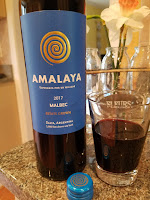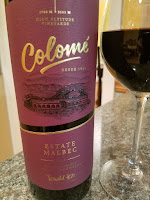 |
| Source: Bodega Colomé |
Imagine an ideal grape growing region. This would most likely be a Mediterranean climate with abundant sunshine, hot days transitioning to cooler evenings, and a strong diurnal shift that extends the growing season and helps retain acidity. The vines would be planted in a mixture of rich volcanic soils or loess or porous limestone. Hail storms, wind chill, and frost would be non-existent threats. Basically Napa Valley.
 |
| Source: Bodega Colomé |
However, viticulture occurs throughout the world where grape growers operate under very extreme conditions -- from high altitudes to northern frost to crushing heat and humidity. There are beachfront vineyards in Colares Portugal, vines buried several feet below the surface in Prince Edward Island Canada, and vines planted between 7,000 and 10,000 feet in Argentina's Salta's Calchaquí Valley. These high altitude vineyards face a greater risk of frost damage and most importantly, failure of the grapes to fully ripen due to wind chill.
 |
| Source: Bodega Colomé |
Bodega Colomé is one of the oldest working wineries in Argentina and home to the highest vineyards in the world (excluding Tibet, which recently planted high altitued vineyards). Located in Salta's Calchaquí Valley, the winery was established in 1831 when the vineyards were first planted on original rootstock imported from Bordeaux -- and these vines are still bearing fruit today. In 2003, the winery planted a trial one-hectare vineyard practically two miles above sea level.
 |
| Source: Bodega Colomé |
This
Altura Maxima Vineyard (“Maximum Height”) is perched at 3,111 meters (10,207 feet) and receives greater sun exposure as well as a wider diurnal variation where the temperature ranges between 18ºC and 33ºC between day and night. The extreme altitude actually helps facilitate the uniform and balanced development of the grapes. But which grapes? According to
Martin Coscia, Brand Manager for
Hess Family Latin America and an expert in high elevation vineyards, "We learned rather quickly that varieties which required long ripening cycles were not going to work – so we turned to Malbec".
 |
| Source: Bodega Colomé |
The inaugural release of the Altura Maxima Malbec occurred in 2012 with the current release being the
2015 Altura Maxima Malbec ($135). The wine was barrel-aged for 24 months but Coscia states that "the true expression of terroir in this Malbec comes from the extreme altitude as well as soil composition – alluvial, sandy soils with a high percentage of gravel.” He continues, “with a semiarid-desert climate, grapes receive much more sun, much less UV protection and produce thicker-skinned grapes that deliver a robust mouthfeel supported by fresh acidity with surprising finesse.”

The
Altura Maxima Malbec is pricey, so for more budget-conscious consumers, Colomé also produces wine from three other high elevation vineyards:
La Brava Estate (5,700 feet),
Colomé Estate (7,500 feet), and
El Arenal Estate (8,800 feet). These vines and grapes face the same challenges but also receive equivalent sun exposure and acid inducing diurnal temperatures. That being said the La Brave vineyard is known for providing intense and ripe fruit, the Colomé Estate lends complexity and weight, and the El Arenal vineyard yields elegance and freshness. These vineyards are reflected in the
Colomé Autentico Malbec 2017 ($32) and the
Colomé Estate Malbec 2016 ($28). Cheers.

















